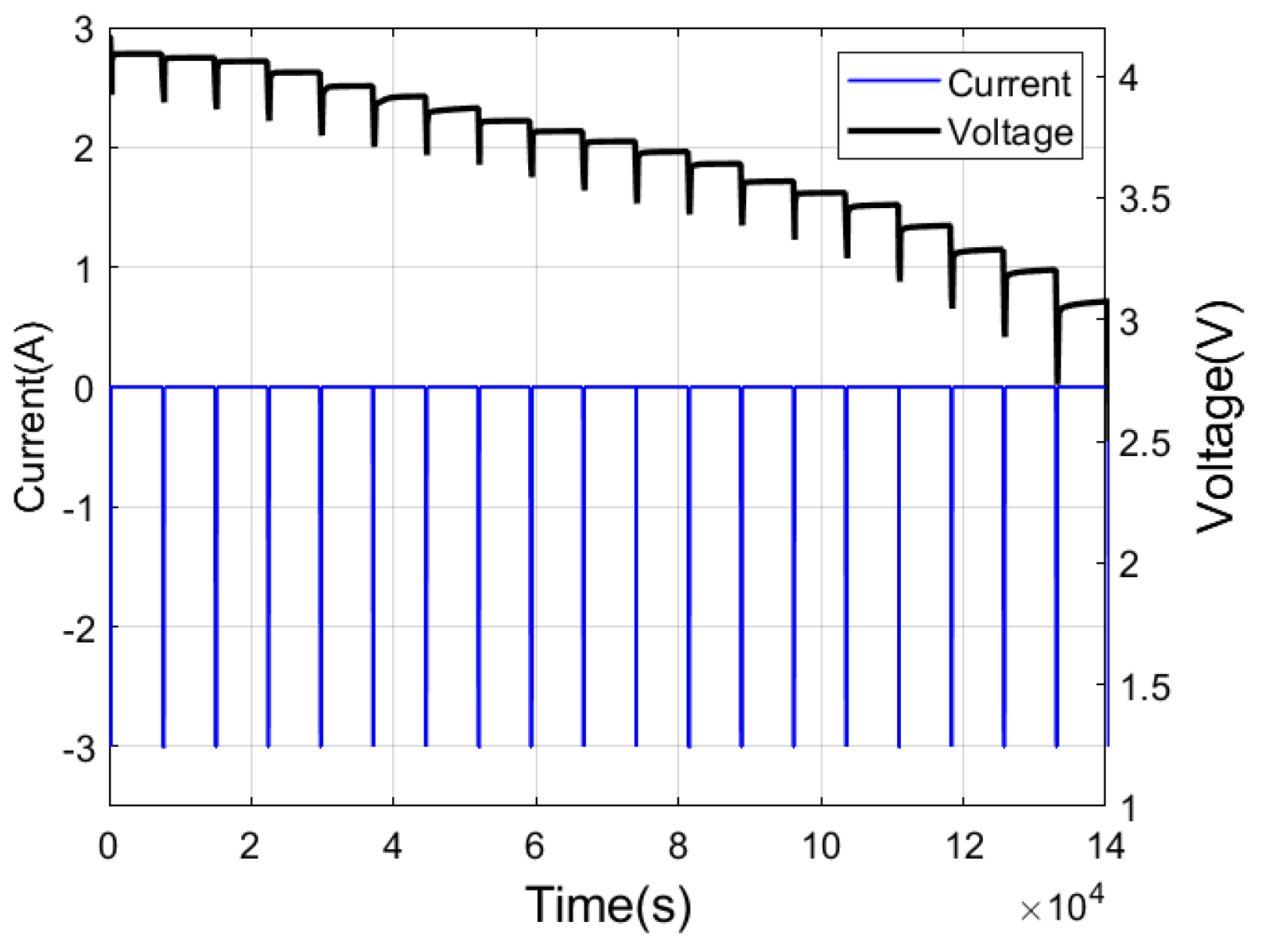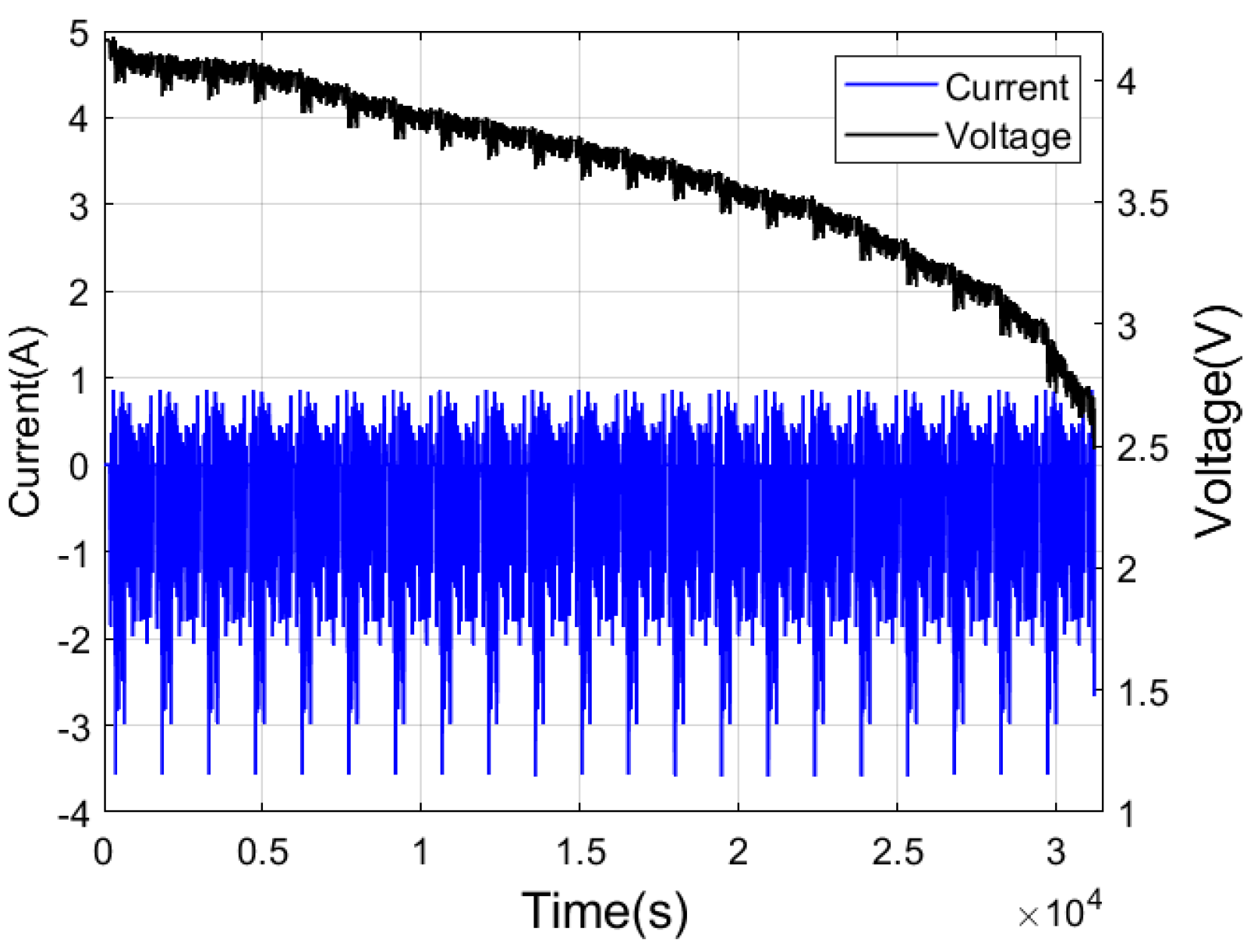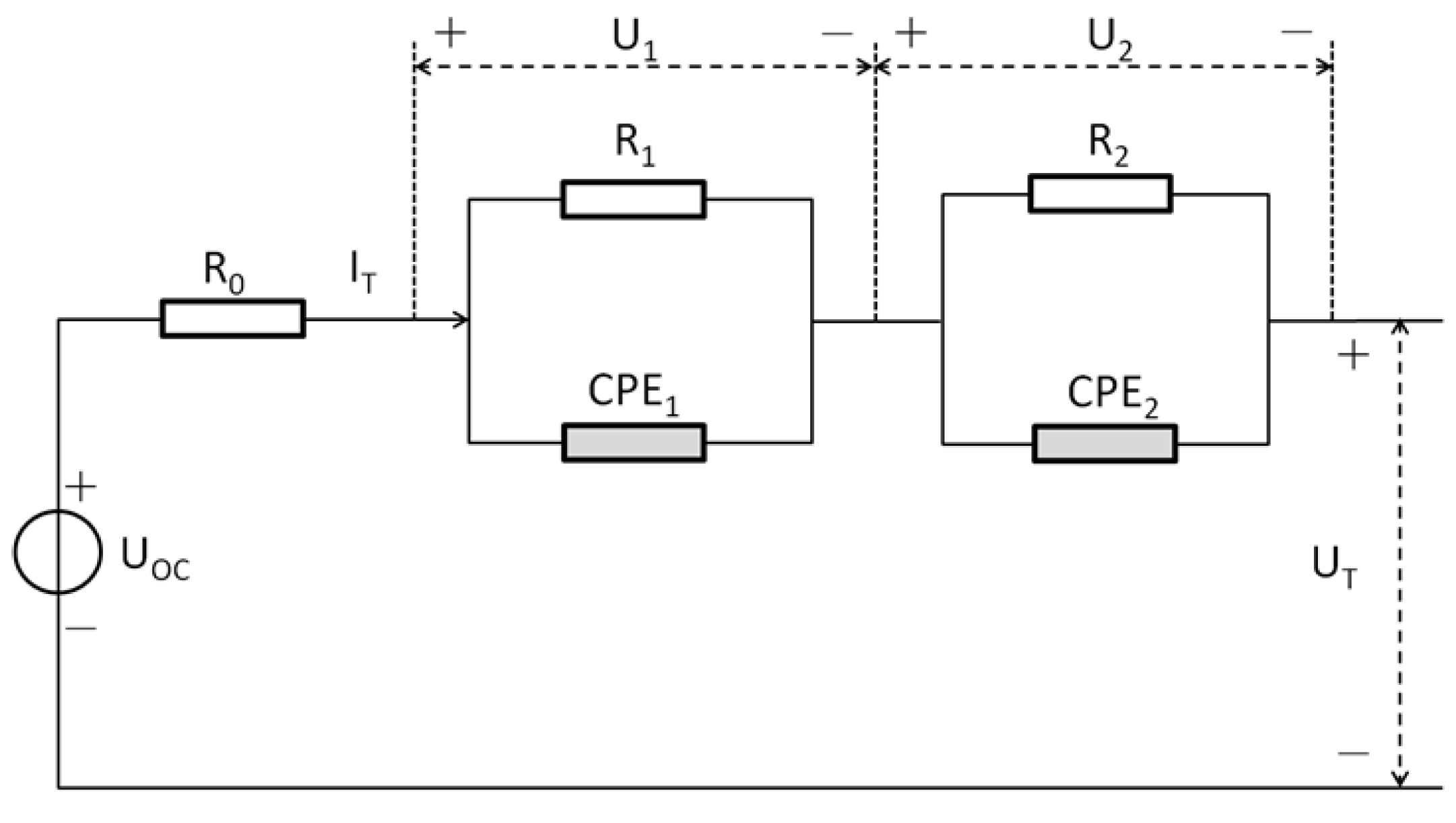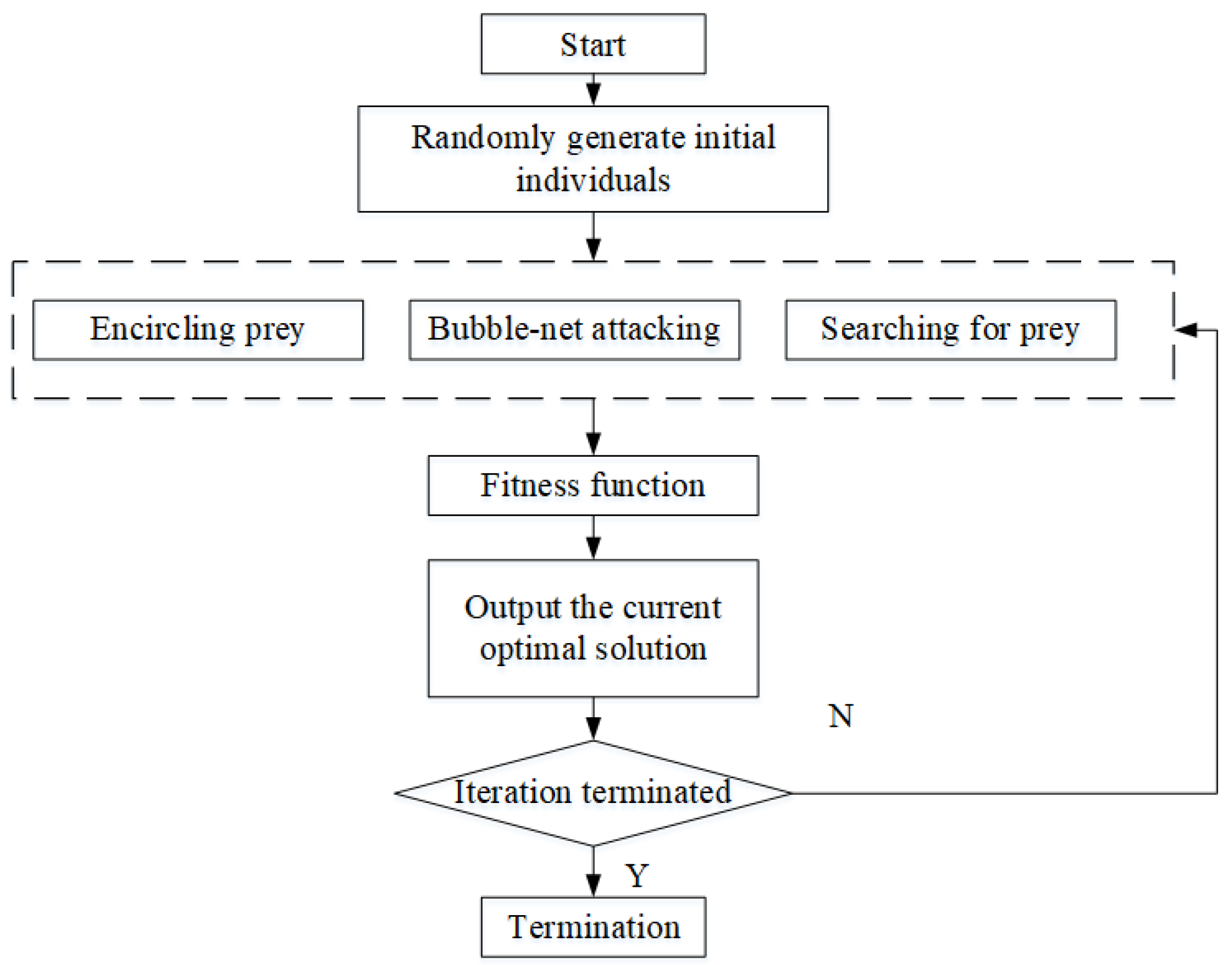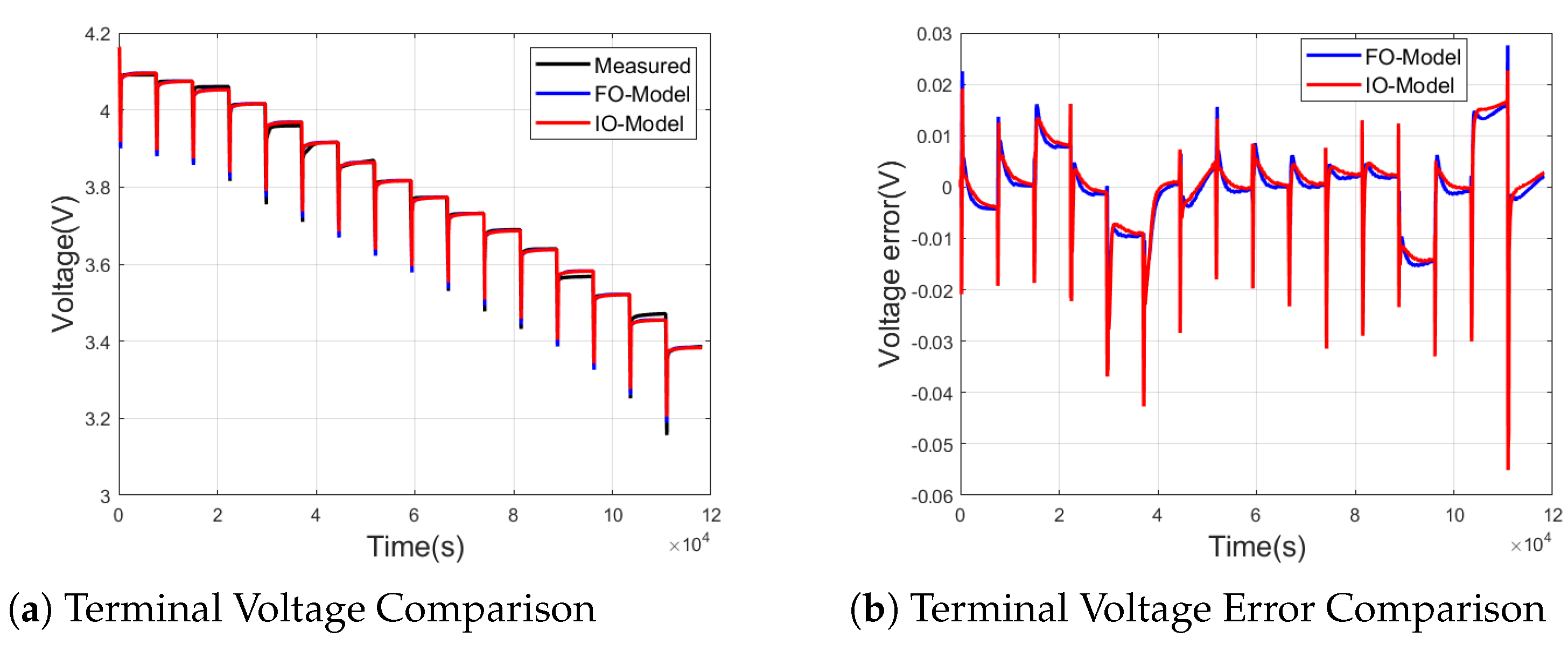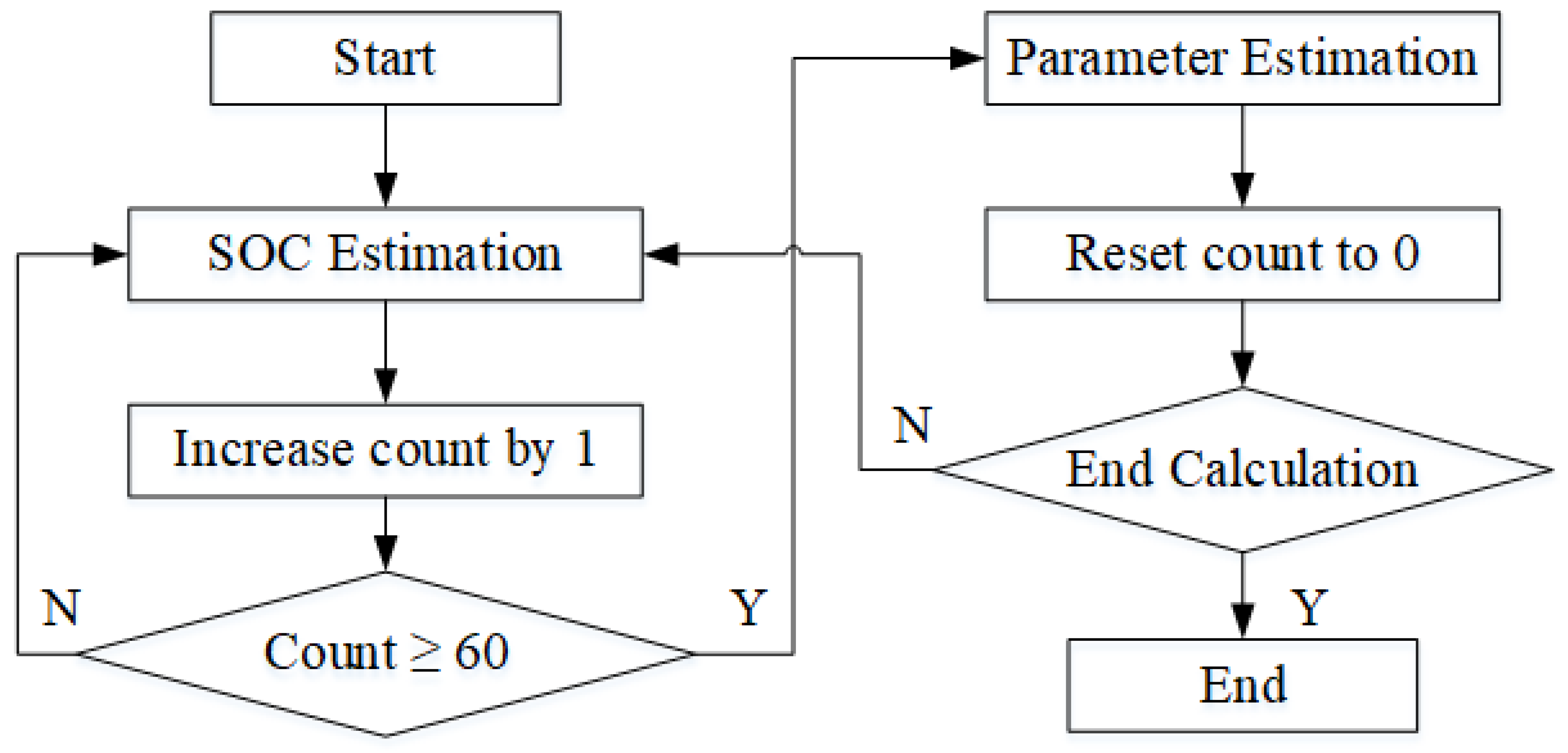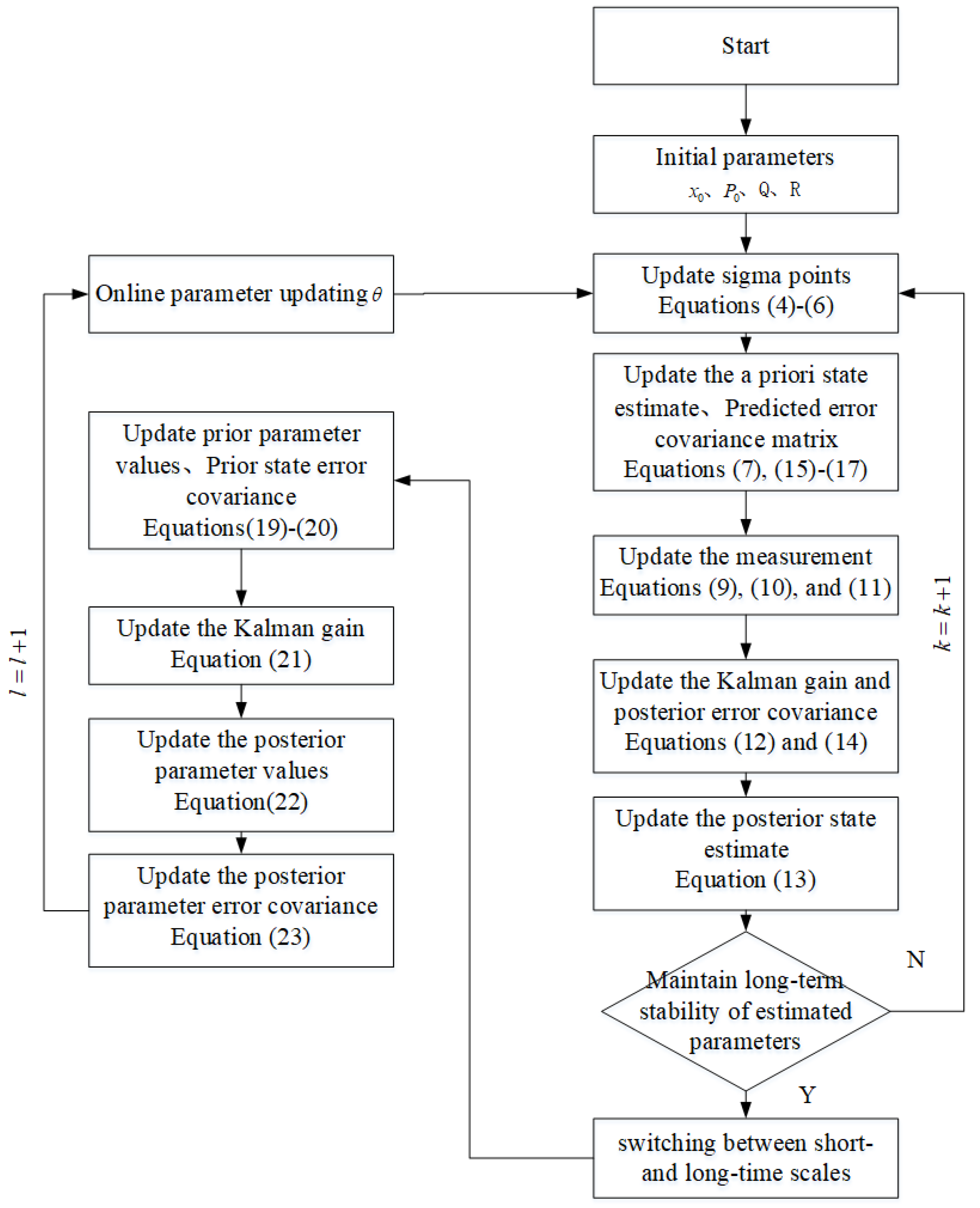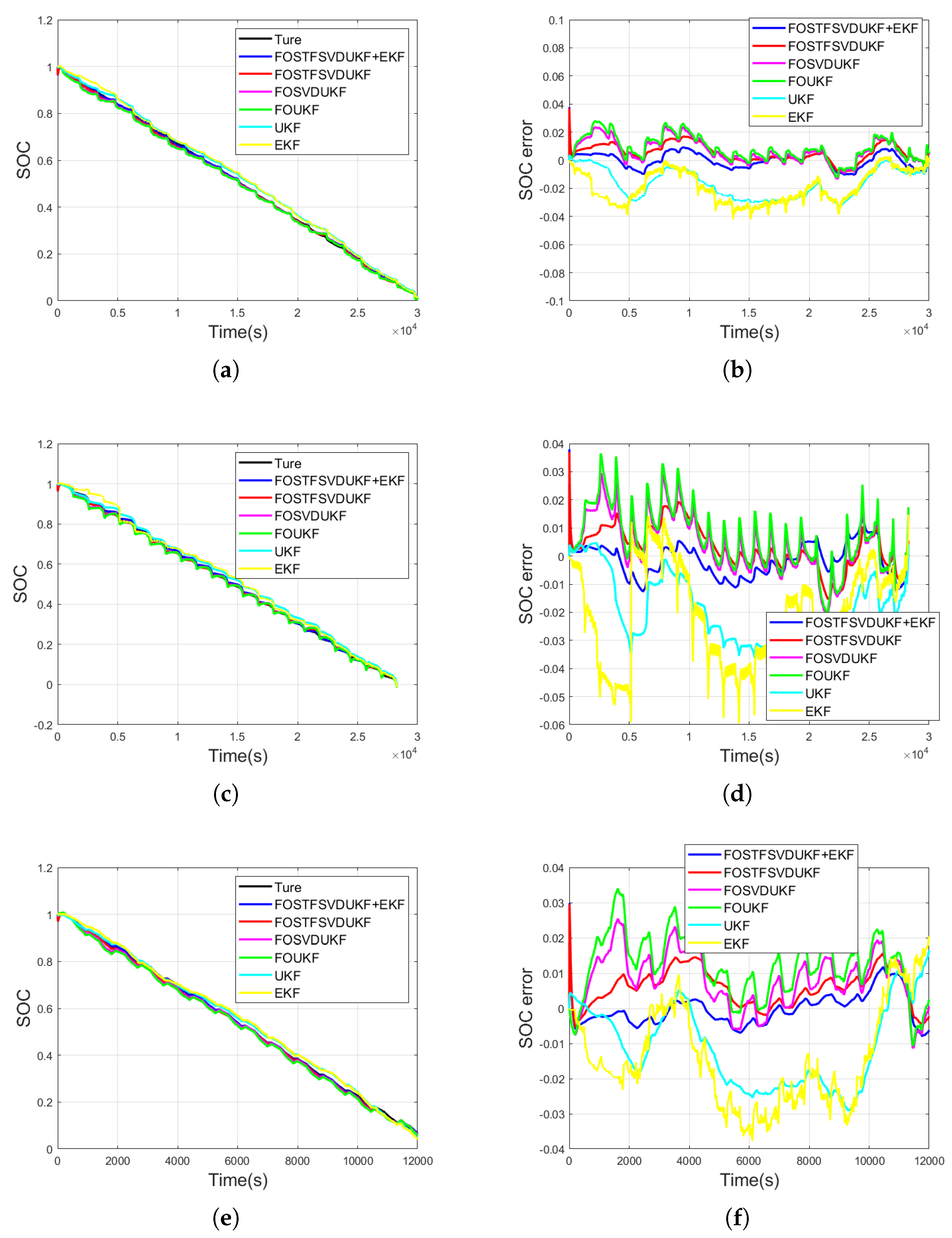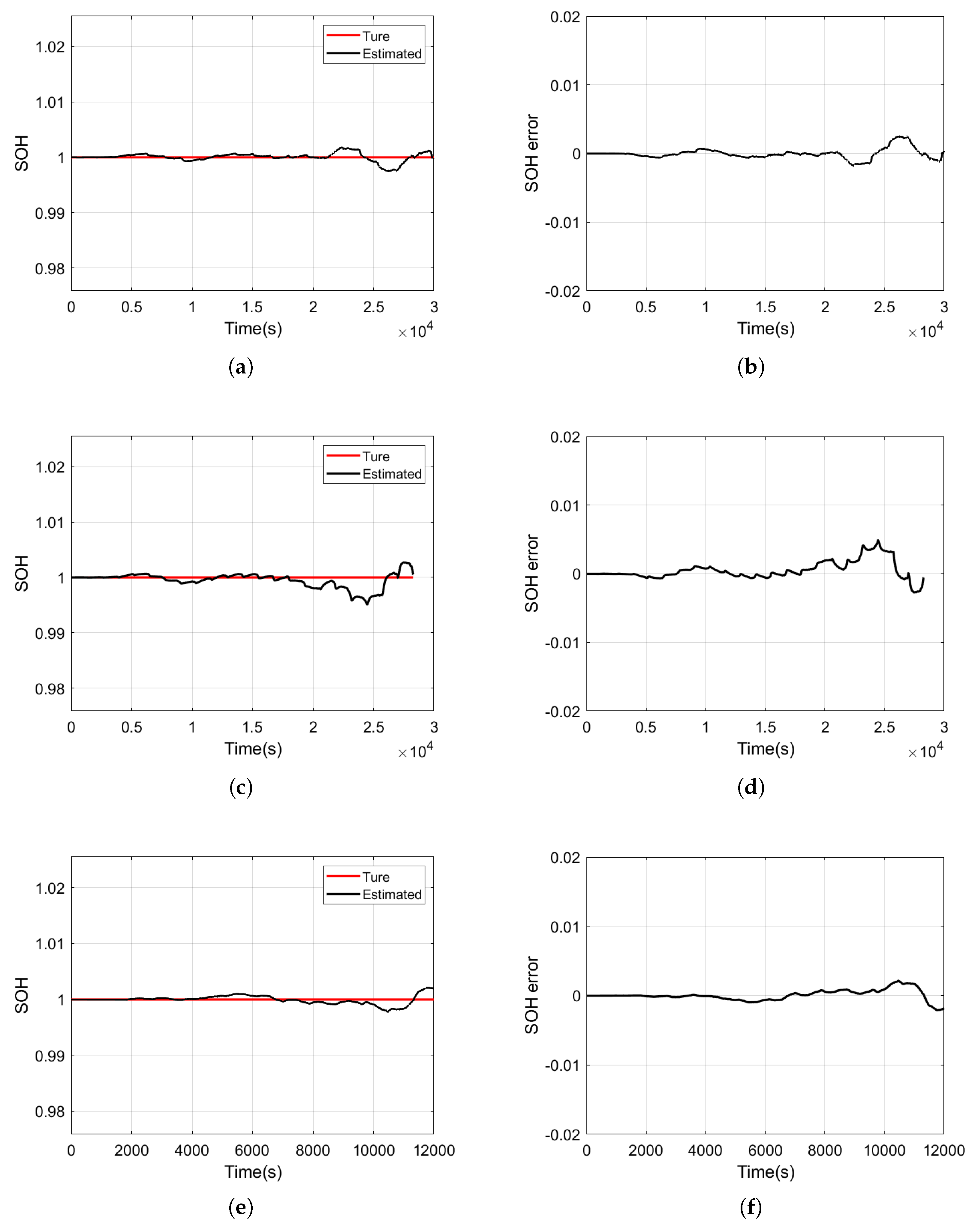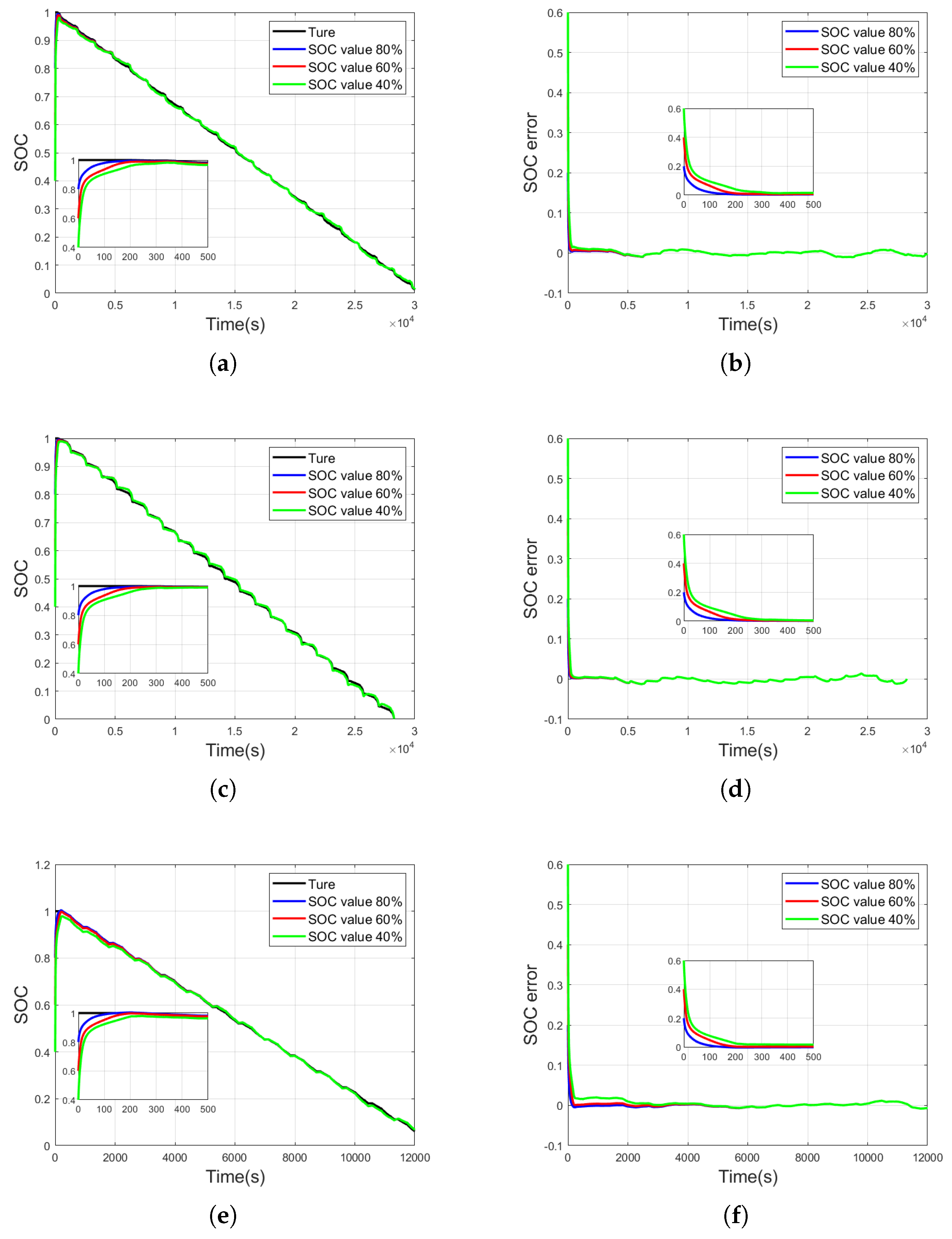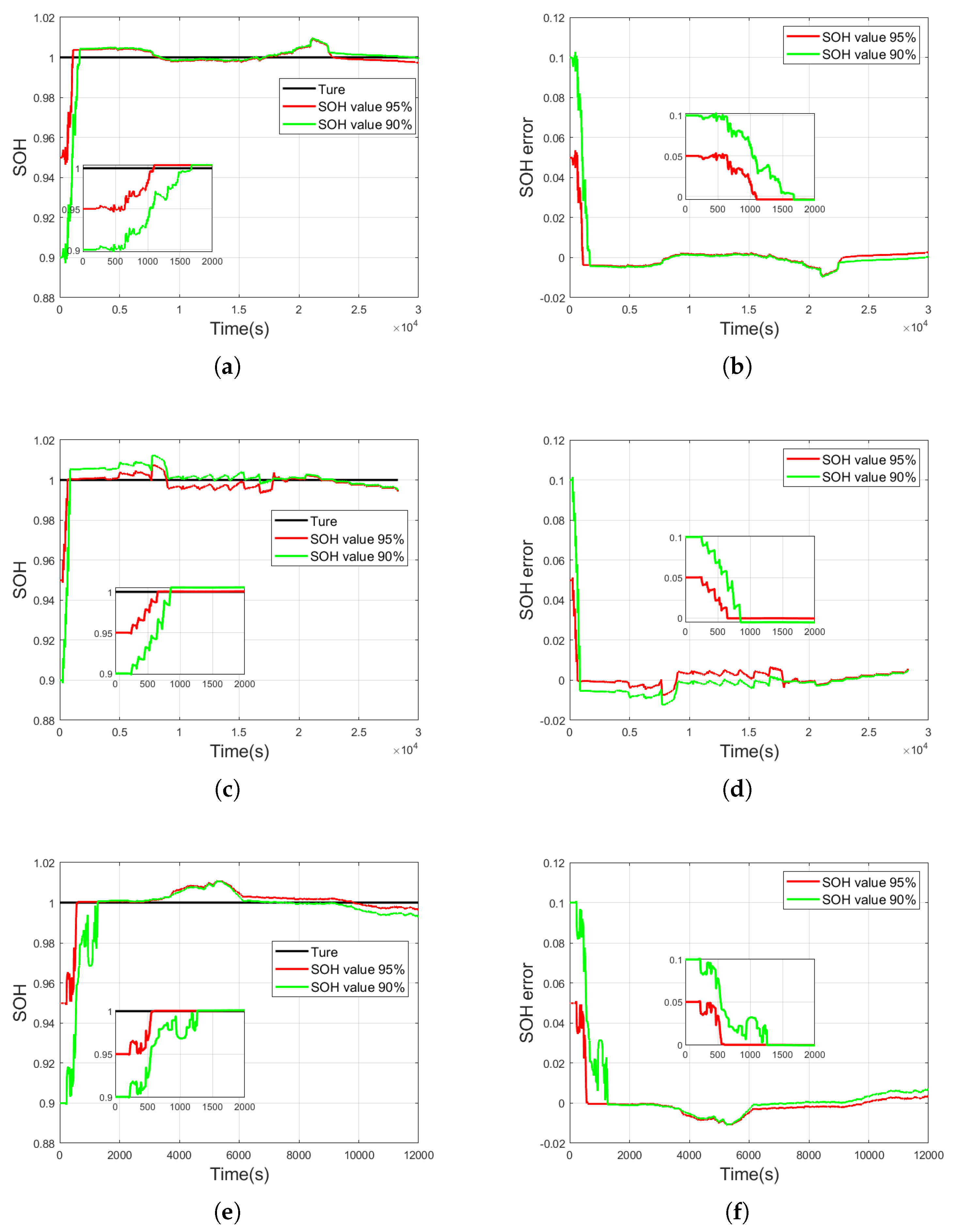3.2. Improved UKF Algorithm
The extended Kalman filter (EKF) is a commonly used method for SOC estimation. Based on the established state observation equations, the EKF uses terminal voltage measurements for correction to achieve optimal SOC estimation. Lithium-ion batteries are nonlinear systems, and during the SOC estimation process, the EKF linearizes the system using the Jacobian matrix, which increases SOC estimation errors. The UKF (unscented Kalman filter) algorithm generates a set of sampling points using the unscented transform to capture the distribution characteristics of nonlinear systems, thereby improving the accuracy loss caused by the linearization process in the EKF. When calculating the sigma sampling points, the UKF algorithm uses Cholesky decomposition on the covariance matrix. However, when the system is disturbed by measurement noise, which leads to abnormal observations, the covariance matrix may lose its positive definiteness, potentially causing the UKF algorithm to halt or terminate. To overcome this issue, singular value decomposition (SVD) is used to replace the Cholesky decomposition in the traditional UKF algorithm. The process of the improved UKF algorithm is shown below.
(1) Set the initial values of the state vector , the initial posterior state estimation error covariance , the system noise covariance matrix Q, and the measurement noise covariance R.
(2) At any arbitrary time
k, perform singular value decomposition (SVD) on the posterior state estimation error covariance matrix
.
(3) Update the sigma sampling points.
Here,
L represents the dimension of the state vector, and the other weight values are calculated as follows:
Here, take
,
,
.
(4) Update the prior state vector
and the system variance prediction
.
(5) Update the observation value
and the predicted observation variance
.
Here,
denotes the observation noise covariance matrix.
(6) Update the covariance
and the Kalman gain
.
(7) Update the posterior state vector
and the posterior state estimation error covariance
.
3.3. Strong Tracking Algorithm
During the operation of lithium-ion batteries, the charge and discharge currents are highly variable, the operating temperature range is wide, and the usage conditions are complex. When the system is subjected to external disturbances that lead to increased SOC estimation errors, the algorithm needs to have the capability of rapidly tracking and converging the SOC estimate. In other words, when the initial SOC is inaccurate, the algorithm should be able to make the SOC estimate converge to the true state value within a small number of iterations so as to provide more accurate battery state information. To achieve this objective, this paper introduces the strong tracking algorithm to enable fast convergence under inaccurate initial SOC conditions. During the initial operating stage, a large SOC error results in increased innovation. The strong tracking algorithm adjusts the covariance and Kalman gain based on the innovation magnitude, enhancing the sensitivity of the algorithm to terminal voltage errors. As a result, the SOC estimate can rapidly track the true SOC value. The modified covariance matrix is expressed as follows:
Here,
denotes the strong tracking coefficient. When the innovation value is large, it indicates that the algorithm has not yet completed the convergence process and a fading factor needs to be introduced so that the strong tracking coefficient becomes
. When the innovation value is small, it indicates that the algorithm has entered a converged state and the fading factor is no longer required, allowing the algorithm to proceed in the conventional manner. The expression of the strong tracking coefficient
is as follows:
denotes the trace of matrix
and
represents the variance of the true innovation. The innovation window size is
M.
3.4. SOC and Parameter Collaborative Estimation Algorithm
Accurate SOC estimation relies on a high-precision battery model, which includes parameters such as the battery’s ohmic resistance, polarization resistance, polarization capacitance, fractional-order parameters, and the current maximum available capacity. Offline parameter identification is based on existing data, where optimization algorithms are used to obtain the equivalent circuit model parameters for the battery’s current state. However, the parameters of the equivalent circuit model change with variations in environmental temperature, battery aging, SOC, and charge/discharge current rates. When the battery’s state undergoes significant changes, the previously established model parameters may result in larger errors compared to the current state, which leads to increased SOC estimation errors and distorted state estimates.
To address the issue of SOC estimation accuracy under full operating conditions and throughout the battery’s entire service life, it is necessary to track the changes in battery model parameters in real time to ensure model accuracy and enable precise SOC estimation. Based on this, this paper develops an SOC and parameter collaborative estimation algorithm, in which the EKF (extended Kalman filter) algorithm is employed to update the model parameters in real time and track their variations during the battery charge and discharge processes. The procedure of EKF-based parameter estimation is as follows:
(1) Set the initial values of the parameter vector , the initial posterior parameter estimation error covariance , the system noise covariance matrix , and the measurement noise covariance . Here, .
(2) Update the prior parameter vector
.
(3) Update the prior parameter estimation error covariance
.
(4) Compute the Kalman gain
for the parameter vector.
Here,
denotes the derivative of the terminal voltage with respect to the parameter vector at time
.
(5) Update the posterior parameter vector
.
(6) Update the posterior parameter estimation error covariance.
For time-varying battery systems, during the charge and discharge processes, the SOC is highly sensitive to temporal variations, whereas the model parameters are less sensitive to changes over time. In other words, SOC is considered a fast time-varying parameter, while the model parameters are regarded as slow time-varying parameters. As illustrated in
Figure 6, based on the time-varying characteristics of SOC and the model parameters, different estimation frequencies need to be set for SOC estimation and parameter estimation. Specifically, the estimation frequency for SOC should be higher than that for the parameters, thereby establishing a multi-time-scale collaborative estimation algorithm. For the slowly varying model parameters, estimation is performed on a macro time scale. In contrast, for the rapidly varying SOC, estimation is performed on a micro time scale. That is, within a function operating cycle of TTT, for every 60 state estimations, the algorithm performs one parameter estimation.
The procedure of the SOC and model parameter collaborative estimation algorithm based on the fractional-order model is as follows:
The procedure of the SOC and model parameter collaborative estimation algorithm based on the fractional-order model is visually summarized in
Figure 7 and can be described as follows:
